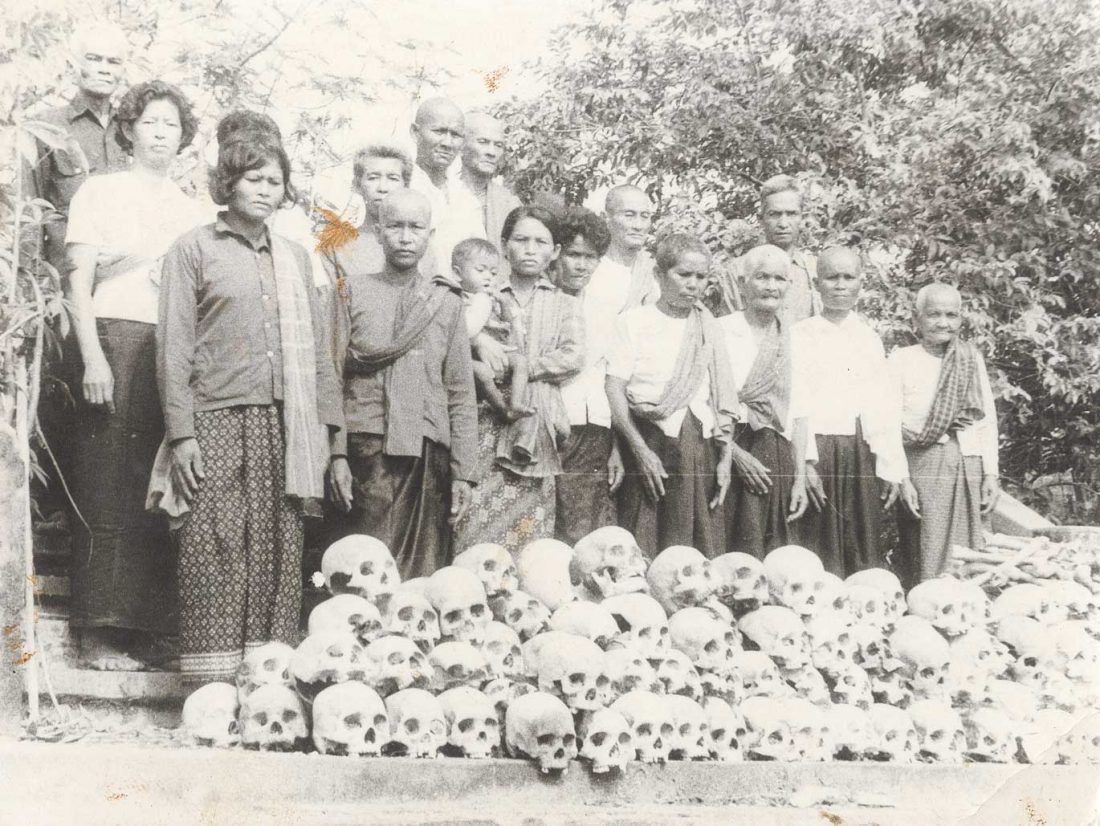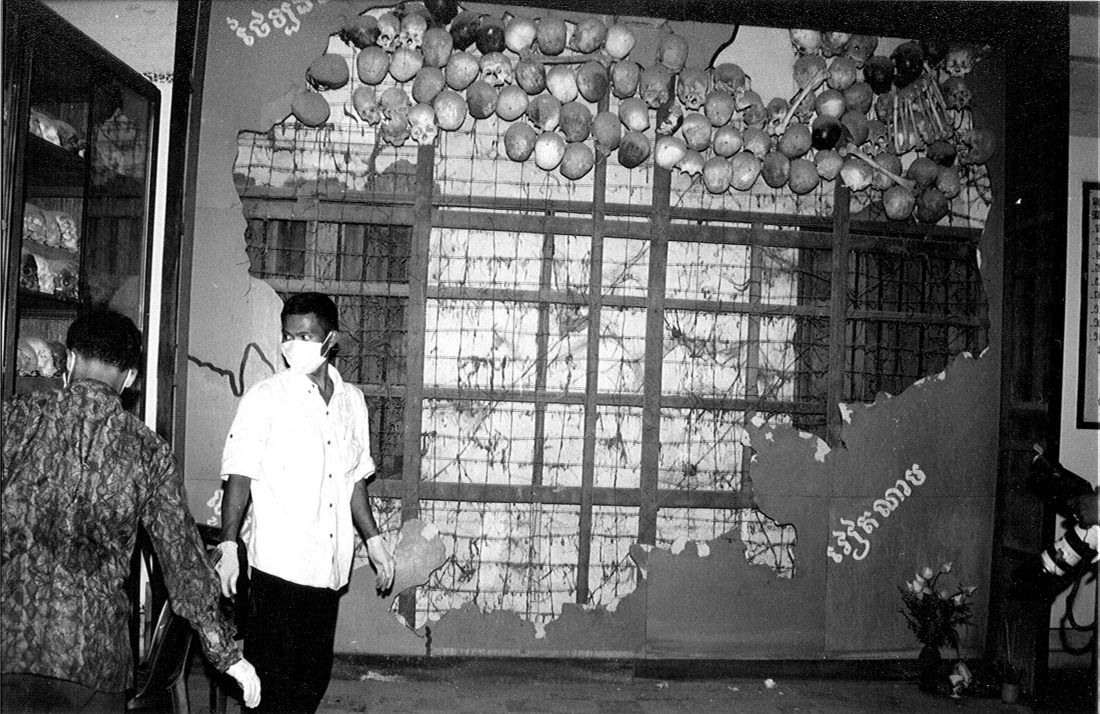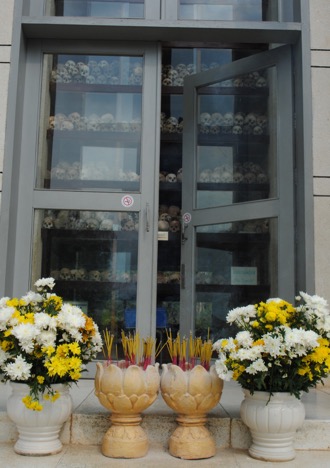June 29, 2016 Asia Foundation
By Terith Chy
One decade ago, Cambodia’s Khmer Rouge tribunal began the arduous and emotional process of seeking justice for some 1.7 million Cambodians who died under the Khmer Rouge’s Democratic Kampuchea regime. Many contentious issues still remain unresolved, including the debate over whether the bones of victims should continue to be displayed in stupas and memorials across Cambodia.

Survivors stand next to remains of victims in the early 1980s. Photo/Mai Lam in 1982/Documentation Center of Cambodia Archives
In the early 2000s, the then-King Norodom Sihanouk, who also lost many of his immediate family members and relatives to the regime, repeatedly appealed for the cremation of the bones of Khmer Rouge victims displayed in stupas around the country. In 2001, he wrote to Prime Minister Hun Sen asking that the skulls be removed from an infamous map at Tuol Sleng Genocide Museum, and be “cremated in the Buddhist way.” One year later, the skulls were removed and the prime minister expressed his willingness to hold a national referendum over the issue. However, the debate over how to handle the remains has gradually disappeared to give way for the negotiation, establishment, and then operation of the tribunal. King Sihanouk died in 2012, and today, the question over how to handle the bones remains unanswered.
Cremating the dead has been a practice and tradition in Cambodia for a very long time. Cambodian Buddhists, who make up about 95 percent of the population, believe that the cremation and other religious rituals help transition the dead to rebirth. As a tradition, family members store the ashes in a stupa mostly held within pagodas, so that the soul of the dead can move on to reincarnation. A renowned Cambodian anthropologist Ang Choulean, who also lost his family member to the regime, somewhat echoed the late King’s appeal in the new documentary, “The Silent Rice Field of Bakan,” upon his first visit to the Tuol Sleng Genocide Museum. For him, it was depressing and disrespectful to those who died for their remains to be displayed in such a way.

A map of Cambodia made of the remains of the victims at the Tuol Sleng Genocide Museum. The map was dismantled in 2002. Photo/Mai Lam in 1982/Documentation Center of Cambodia Archives
On the other side of the debate is the opinion that preserving the remains is a critical reminder of the crimes of the Khmer Rouge and serves as an educational tool for future generations of Cambodians. It has been four decades since the Khmer Rouge came to power, and 37 years since the regime collapsed. Many argue there is a need to look back and assess the extent to which Cambodia has dealt with its painful past. However, as the Khmer Rouge identity remains deeply embedded in the Cambodian psyche, shame, denial, and fear contribute to avoiding discussion around history, particularly when such conversations turn to personal experiences. For the same reasons, many former Khmers Rouge discourage their children from learning the relevant history. Preserving remains, some argue, is a way of making sure the country’s tragic history is not forgotten.
Remains held in a stupa at the Killing Fields.

Remains held in a stupa at the Killing Fields. Photo/Chy Terith
Ultimately, the country has to come to a decision about what to do with those remains. A national referendum appears to be one of the best means to seek the majority’s decision on this lingering issue. Nonetheless, any measure to deal with this issue should take into account the various minority groups who are not Buddhists and who may have a different tradition of dealing with the remains. And it makes more sense that it should take place sooner rather than later because any such measure would certainly help bring some sense of closure and healing to the living victims, knowing that the souls of their family members and relatives no longer wander around and can now transition to rebirth.
There seems to be a consensus that the question on what to do with the remains would only be discussed after the Khmer Rouge tribunal has completed its prosecution process, assuming that the tribunal would need to use the remains as evidence in the legal proceedings. At this stage, when this process will be complete is unknown to the public. Therefore, any forensic examination of the bones, if any, should have been completed by now. The time is ripe to renew the discussion on one of the last measures for those who are no longer with us. And perhaps, a national referendum as suggested by the prime minister is one of the ways to finally resolve this issue in the end.
Chy Terith is Program Director for The Asia Foundation in Cambodia, a 2015 Asia Foundation Development Fellow, and an executive officer at the Documentation Center of Cambodia (DC-Cam). The views and opinions expressed here are those of the individual author and not those of The Asia Foundation or its funders.

1 comment:
I bet the skulls scare away International investors. It's the Vietnamese scheme to drive away investment in Cambodia.
Post a Comment